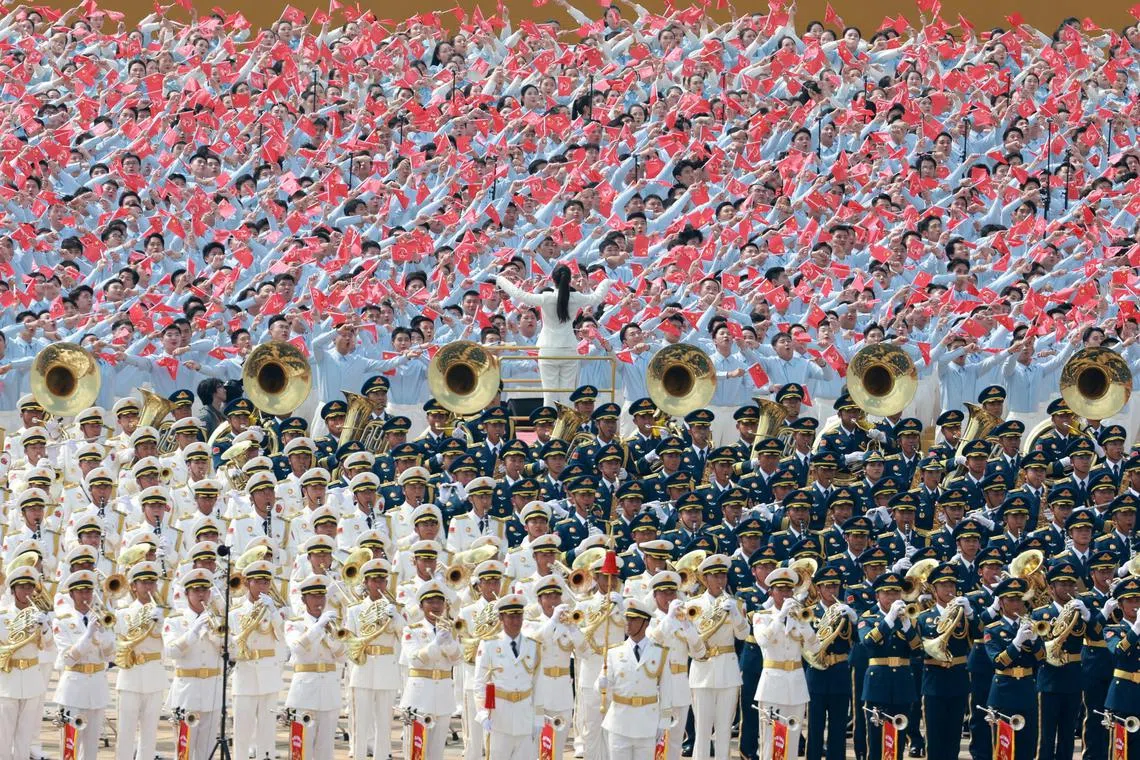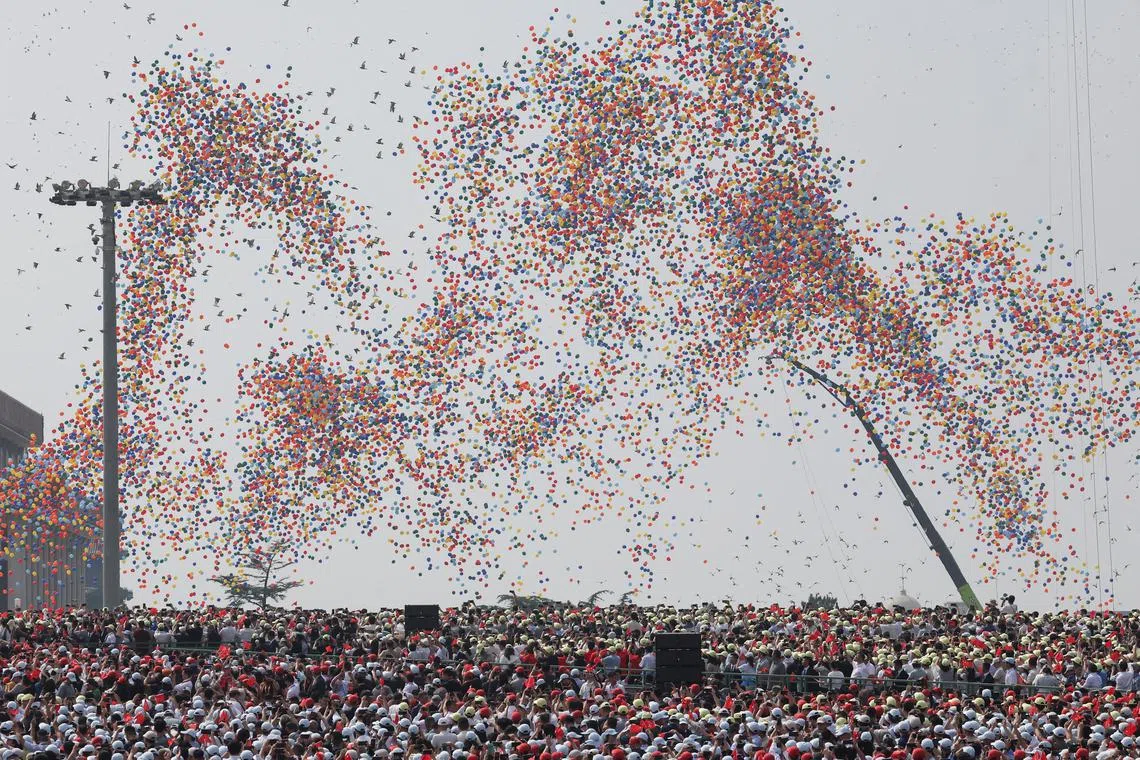In Beijing, a parade of power and patriotism evokes pride and belonging
Sign up now: Get ST's newsletters delivered to your inbox
Follow topic:
- China held a military parade showcasing its strength and patriotism, featuring advanced military hardware and floral installations.
- President Xi Jinping stood with Russia's Vladimir Putin and North Korea's Kim Jong Un, signalling solidarity against the West.
- Citizens expressed patriotic fervour, with events like the parade and floral displays fostering national pride and resilience.
AI generated
BEIJING – Beijing came to a standstill on the morning of Sept 3 as seven J-10 jets streaked overhead, leaving 14 ribbons of coloured smoke across a clear blue sky, with collective exclamation from spectators echoing the thunder of the engines.
In China, even the skywriting carries symbolism.
State media said the smoke trails were a tribute to the 14 years of China’s war against Japan and the aspirations of its 1.4 billion citizens.
The jets’ colourful finale capped an intensifying display of new and advanced military hardware that drew increasingly loud cheers from the crowd at the Victory Day parade in Beijing’s Tiananmen Square, held to mark the 80th anniversary of China’s victory over Japan and the end of World War II.
Besides showcasing China’s military muscle, the parade was a carefully choreographed spectacle designed to bolster patriotism and public confidence at a time of intensifying geopolitical turbulence.
China’s rivalry with the US has deepened in recent years, with tensions escalating over trade, technology and regional security.
In what many viewed as a symbolic show of defiance and solidarity, Chinese President Xi Jinping on Sept 3 walked into Tiananmen Gate Tower flanked by Russian President Vladimir Putin and North Korean leader Kim Jong Un, two leaders shunned by the West North Korea contributed troops

(From left) Russian President Vladimir Putin, Chinese President Xi Jinping, North Korean leader Kim Jong Un, Pakistan’s Prime Minister Shehbaz Sharif and heads of foreign delegations arriving for a military parade in Beijing on Sept 3.
PHOTO: REUTERS
TV footage of the trio, aired live globally, elicited an immediate response from US President Donald Trump, who said in a Truth Social post directed at Mr Xi: “Please give my warmest regards to Vladimir Putin and Kim Jong Un as you conspire against the United States of America.”
At the Tiananmen Gate Tower, Mr Xi, who took the middle host seat, was flanked by Mr Putin and Mr Kim. To Mr Kim’s left sat Kazakhstan President Kassym-Jomart Tokayev, while Indonesian President Prabowo Subianto, who made a last-minute decision to attend the parade after initially cancelling the trip over protests at home, sat on the right side of Mr Putin.
The parade comes as China faces mounting challenges at home, from sluggish economic growth and a weak job market to a prolonged property crisis, which has left some Chinese feeling the squeeze.
But on Sept 3, as the uniform thud of boots on asphalt echoed across Tiananmen Square, those worries were momentarily set aside.

Military band and choir members performing in a military parade in Beijing on Sept 3.
PHOTO: REUTERS
Parade spectators – all of whom were handpicked to attend – waved national flags in unison to soaring patriotic songs praising the Communist Party of China (CPC) and pledging loyalty to the nation, and clapped enthusiastically whenever Mr Xi or a foreign leader appeared on the giant screens.
Beijing native Yan Zi, whose 10-year-old son was selected by his school to attend the parade, said it was important to her that her son knew about how the country had overcome hardship.
“Patriotic education must be rooted in his heart and it starts from home. It builds his self-confidence to know that his country now is strong and mighty,” said Ms Yan.
Her son, dressed in a red scarf symbolising the blood of revolutionary martyrs and a lapel pin marking him as a member of the CPC’s youth wing, Young Pioneers of China, said he was “wide awake” and “ready to cheer for the military march-past” despite having left home as early as 2.30am.
The parade, China’s second of its kind after the inaugural event in 2015, was the culmination of months of preparation. In August, some areas in central Beijing were sealed off for three overnight rehearsals, including one full-dress rehearsal, to fine-tune every detail of the show.
On the eve of the parade, this reporter rode in a private-hire car whose driver, unprompted, exclaimed as he cruised down an unusually empty road in central Beijing: “How fortunate are we to be driving through the city with police stationed every 100m!”
With no rides expected during the parade hours, he said he planned to take his seven-year-old son as close to Tiananmen Square as possible, in the hope that they might catch a glimpse of the spectacle and marvel up close at the advanced military hardware.
In the lead-up to the parade, 10 elaborate 3D floral installations were erected along Chang’an Avenue, which runs through the heart of Beijing near landmarks like Tiananmen Square. Each installation was designed to depict either China’s wartime victories or its vision of national rejuvenation, serving as carefully crafted visual narratives that set the tone for the Sept 3 parade.
One installation, titled Ode To The Yellow River, featured a mist-shrouded recreation of Hukou Waterfall, a symbol of national resilience, and played patriotic melody Defend The Yellow River.
Crops such as millet, sorghum and sugar cane, which evoke China’s wartime self-reliance and agricultural resilience, were incorporated into these displays.
On Chinese social media platforms, these floral installations became popular photo spots as the parade day drew near.

Balloons being released during a military parade to mark the 80th anniversary of the end of World War II, in Beijing, China, on Sept 3. REUTERS/Maxim Shemetov
REUTERS
The 90-minute parade, longer than the initially planned 70 minutes, ended with a flourish: A large number of doves, reportedly 80,000, were released into the sky to symbolise peace, followed by a cascade of colourful balloons.
A retired military officer, visibly moved by the day’s patriotic display, was seen doing a video interview with a Chinese media outlet, gesturing animatedly as he praised the strength of the nation.
Even after the final formations had passed and the jets had faded into the distance, families and members of various organisations stayed behind to take photos, wave flags and soak in the moment, a reminder that for many Chinese, the parade was about pride and a sense of belonging.


